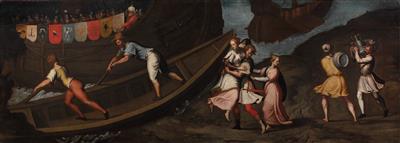Bernardino Campi

(Cremona 1522–1591 Reggio Emilia)
Abduction of Helen,
oil on canvas, 97 x 297 cm, framed
Provenance:
possibly Palazzo Gonzaga, Guastalla, Reggio Emilia;
Private collection, Italy
Exhibited:
Cremona, Santa Maria della Pietà, Vecchio Ospedale, Museo Civico, Sala Manfredini, I Campi e la cultura artistica cremonese del Cinquecento, 1985, n. 1.15.19
Literature:
R. Miller, in: M. Gregori (ed.), I Campi e la cultura artistica cremonese del Cinquecento, exhibition catalogue, Milan 1985, p. 170, n. 1.15.19, ill.
The present painting is registered in the Fototeca Zeri (no. 31725) as Bernardino Campi.
This painting depicts an episode from the Trojan legend. During a journey to Sparta, Paris, the son of Priam, King of Troy, fell in love with Helen, the beautiful wife of King Menelaus. By abducting Helen and carrying her back to Troy, Paris began a war with Greece. This painting represents the moment when Paris, seen at the centre of the scene, carries the young beauty towards a boat, while in the background two galleons attend to aid their escape.
The present canvas belonged to a series representing episodes of the Trojan war of which two are still in a private collection: The entreaty of Priam and Aeneas’ escape from Troy. These three works might have belonged to part of the decorative programme for one of the rooms in the palace of Ferrante II Gonzaga at Guastalla, near Reggio Emilia, where Bernardino worked from 1587 to 1590. The programme is documented in a series of letters that he wrote during these years (see literature). Indeed, in these letters, the artist refers to the paintings that he was working on for the Camera di Paride, however his descriptions only partially match the three paintings that have survived. Nevertheless, the fact that the paintings have a horizontal format strongly suggests that they belonged to the frieze made for the room.
Bernardino was born in Cremona, his first training took place alongside his father Pietro, a goldsmith, and he subsequently studied in the studio of Giulio Campi. His final apprenticeship was with Ippolito Costa in Mantua where he was influenced by the work of Giulio Romano. The artist’s career was predominantly spent fulfilling commissions for paintings and altarpieces for the noble families of Cremona and Milan. The artist’s fame also led him to work for Duke Vespasiano Gonzaga in Sabbioneta in the early 1580s, and subsequently for Ferrante II in Guastalla, for whose palace the present Abduction of Helen was most probably created. Miller (see literature) observes a certain crudeness in the execution of the figures but as the capomaestro of the Duke, Bernardino was certainly responsible for the overall design and invention of this work.
25.04.2017 - 18:00
- Prezzo realizzato: **
-
EUR 63.500,-
- Stima:
-
EUR 60.000,- a EUR 80.000,-
Bernardino Campi
(Cremona 1522–1591 Reggio Emilia)
Abduction of Helen,
oil on canvas, 97 x 297 cm, framed
Provenance:
possibly Palazzo Gonzaga, Guastalla, Reggio Emilia;
Private collection, Italy
Exhibited:
Cremona, Santa Maria della Pietà, Vecchio Ospedale, Museo Civico, Sala Manfredini, I Campi e la cultura artistica cremonese del Cinquecento, 1985, n. 1.15.19
Literature:
R. Miller, in: M. Gregori (ed.), I Campi e la cultura artistica cremonese del Cinquecento, exhibition catalogue, Milan 1985, p. 170, n. 1.15.19, ill.
The present painting is registered in the Fototeca Zeri (no. 31725) as Bernardino Campi.
This painting depicts an episode from the Trojan legend. During a journey to Sparta, Paris, the son of Priam, King of Troy, fell in love with Helen, the beautiful wife of King Menelaus. By abducting Helen and carrying her back to Troy, Paris began a war with Greece. This painting represents the moment when Paris, seen at the centre of the scene, carries the young beauty towards a boat, while in the background two galleons attend to aid their escape.
The present canvas belonged to a series representing episodes of the Trojan war of which two are still in a private collection: The entreaty of Priam and Aeneas’ escape from Troy. These three works might have belonged to part of the decorative programme for one of the rooms in the palace of Ferrante II Gonzaga at Guastalla, near Reggio Emilia, where Bernardino worked from 1587 to 1590. The programme is documented in a series of letters that he wrote during these years (see literature). Indeed, in these letters, the artist refers to the paintings that he was working on for the Camera di Paride, however his descriptions only partially match the three paintings that have survived. Nevertheless, the fact that the paintings have a horizontal format strongly suggests that they belonged to the frieze made for the room.
Bernardino was born in Cremona, his first training took place alongside his father Pietro, a goldsmith, and he subsequently studied in the studio of Giulio Campi. His final apprenticeship was with Ippolito Costa in Mantua where he was influenced by the work of Giulio Romano. The artist’s career was predominantly spent fulfilling commissions for paintings and altarpieces for the noble families of Cremona and Milan. The artist’s fame also led him to work for Duke Vespasiano Gonzaga in Sabbioneta in the early 1580s, and subsequently for Ferrante II in Guastalla, for whose palace the present Abduction of Helen was most probably created. Miller (see literature) observes a certain crudeness in the execution of the figures but as the capomaestro of the Duke, Bernardino was certainly responsible for the overall design and invention of this work.
|
Hotline dell'acquirente
lun-ven: 10.00 - 17.00
old.masters@dorotheum.at +43 1 515 60 403 |
| Asta: | Dipinti antichi |
| Tipo d'asta: | Asta in sala |
| Data: | 25.04.2017 - 18:00 |
| Luogo dell'asta: | Vienna | Palais Dorotheum |
| Esposizione: | 15.04. - 25.04.2017 |
** Prezzo d’acquisto comprensivo dei diritti d’asta acquirente e IVA
Non è più possibile effettuare un ordine di acquisto su Internet. L'asta è in preparazione o è già stata eseguita.
